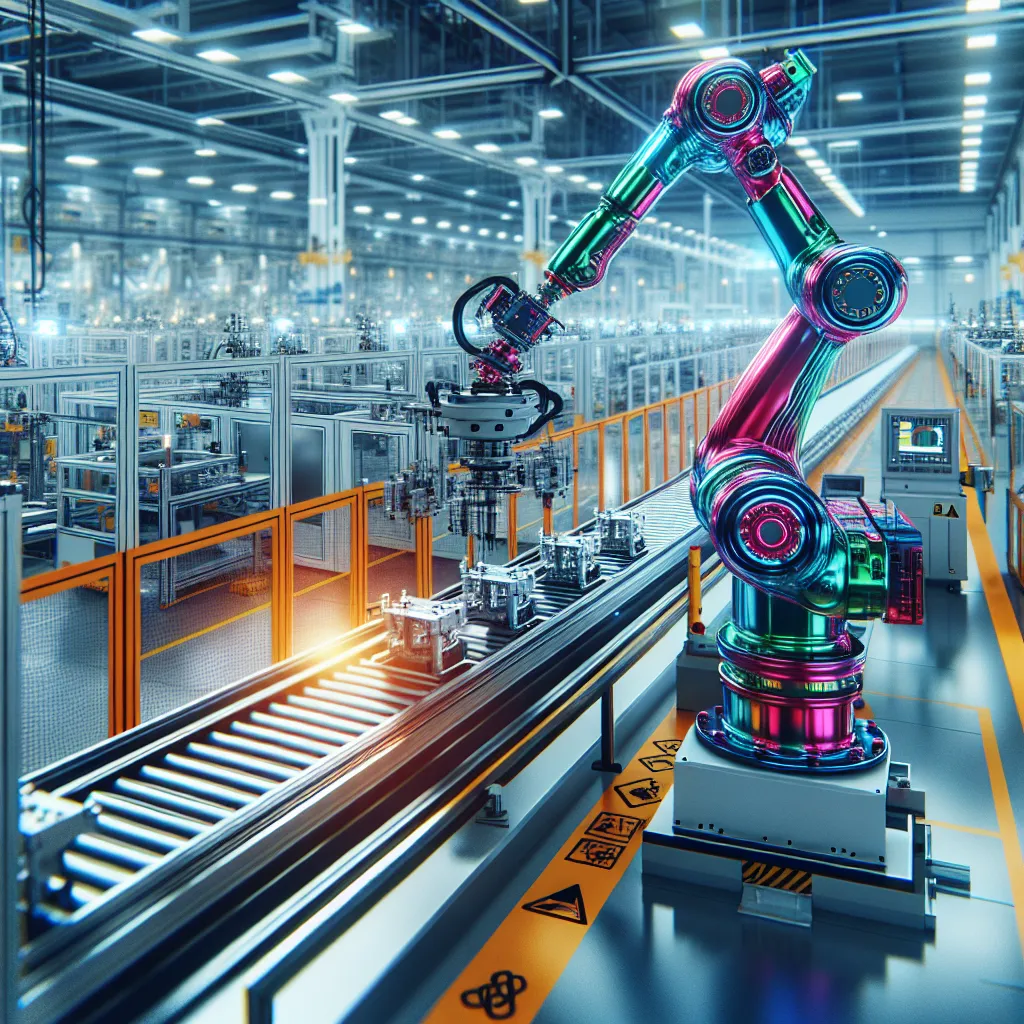In today’s IELTS Reading practice, we’ll explore the fascinating topic of “How automation is influencing manufacturing efficiency.” This subject is not only relevant to the IELTS exam but also reflects the current trends in industry and technology. Let’s dive into a comprehensive reading exercise that will test your comprehension skills while providing valuable insights into the world of automated manufacturing.
Nội dung bài viết
IELTS Reading Test
Passage 1 – Easy Text
The Rise of Automation in Manufacturing
Automation has become an integral part of modern manufacturing processes, revolutionizing the way goods are produced. This technological advancement has led to significant improvements in efficiency, quality, and productivity across various industries. Automated systems, ranging from simple robotic arms to complex artificial intelligence-driven machines, are now commonplace in factories around the world.
 Robotic Arm in Factory
Robotic Arm in Factory
One of the primary benefits of automation is its ability to enhance production speed while maintaining consistent quality. Machines can work tirelessly, performing repetitive tasks with precision that human workers might find challenging to maintain over long periods. This not only increases output but also reduces the likelihood of errors and defects in the final products.
Moreover, automation has played a crucial role in improving workplace safety. By taking over dangerous or physically demanding tasks, robots and automated systems have significantly reduced the risk of workplace accidents and injuries. This shift has allowed human workers to focus on more complex, cognitive tasks that require creativity and problem-solving skills.
The integration of data analytics with automated systems has further boosted manufacturing efficiency. Real-time monitoring and data collection enable manufacturers to identify bottlenecks, optimize processes, and make informed decisions quickly. This data-driven approach has led to smarter resource allocation and reduced waste in production lines.
However, the rise of automation has also raised concerns about job displacement. As machines take over more tasks, there is a growing need for workers to upskill and adapt to new roles that focus on managing and maintaining these automated systems. This transition presents both challenges and opportunities for the workforce in the manufacturing sector.
Despite these challenges, the trend towards automation continues to accelerate. Industry 4.0, characterized by the integration of cyber-physical systems, the Internet of Things, and cloud computing, is set to further transform manufacturing processes. As technology evolves, the influence of automation on manufacturing efficiency is likely to become even more pronounced in the years to come.
Questions for Passage 1
1-5. Do the following statements agree with the information given in the passage?
Write:
TRUE if the statement agrees with the information
FALSE if the statement contradicts the information
NOT GIVEN if there is no information on this
- Automation has decreased the quality of manufactured goods.
- Automated systems can work continuously without fatigue.
- The use of robots in manufacturing has improved workplace safety.
- All manufacturing jobs will be replaced by automated systems in the future.
- Industry 4.0 involves the use of cloud computing in manufacturing processes.
6-10. Complete the sentences below.
Choose NO MORE THAN TWO WORDS from the passage for each answer.
- Automation has led to improvements in efficiency, quality, and ____.
- Machines perform ____ tasks with high precision.
- The integration of ____ with automated systems has improved manufacturing efficiency.
- Workers need to ____ to adapt to new roles in automated manufacturing environments.
- The influence of automation on manufacturing efficiency is expected to become more ____ in the future.
Passage 2 – Medium Text
The Impact of Artificial Intelligence on Manufacturing Processes
The integration of Artificial Intelligence (AI) into manufacturing processes marks a significant leap forward in the ongoing evolution of industrial automation. AI technologies, encompassing machine learning, computer vision, and natural language processing, are revolutionizing the way factories operate, leading to unprecedented levels of efficiency and productivity.
One of the most profound impacts of AI in manufacturing is its ability to enable predictive maintenance. By analyzing vast amounts of data collected from sensors embedded in machinery, AI algorithms can predict when equipment is likely to fail. This proactive approach allows manufacturers to schedule maintenance before breakdowns occur, significantly reducing downtime and extending the lifespan of expensive machinery.
AI-powered quality control systems represent another transformative application in manufacturing. Computer vision algorithms can inspect products at speeds and levels of accuracy far surpassing human capabilities. These systems can detect defects that might be invisible to the human eye, ensuring that only products meeting the highest quality standards reach consumers. This not only improves customer satisfaction but also reduces waste and the costs associated with product recalls.
The concept of the “smart factory” has emerged as a result of AI integration. In these advanced manufacturing environments, AI orchestrates the entire production process, from supply chain management to production scheduling. By analyzing market demand, supply chain data, and production capabilities in real-time, AI can optimize production schedules to meet changing market needs efficiently. This level of responsiveness was previously unattainable with traditional manufacturing methods.
Collaborative robots, or cobots, equipped with AI, are changing the nature of human-machine interaction on factory floors. These intelligent machines can work alongside human workers, adapting to their movements and even learning new tasks through demonstration. This collaboration enhances productivity while allowing human workers to focus on tasks that require creativity and complex problem-solving skills.
However, the implementation of AI in manufacturing is not without challenges. Data security and privacy concerns arise from the vast amounts of data collected and processed by AI systems. Additionally, there is a pressing need for workforce reskilling to manage and maintain these sophisticated AI-driven systems.
Despite these challenges, the potential benefits of AI in manufacturing are too significant to ignore. As AI technologies continue to advance, their impact on manufacturing efficiency is expected to grow exponentially. The factories of the future will likely be characterized by an seamless integration of AI across all aspects of the production process, ushering in a new era of manufacturing efficiency and innovation.
Questions for Passage 2
11-14. Choose the correct letter, A, B, C, or D.
-
According to the passage, predictive maintenance in manufacturing:
A) Completely eliminates the need for equipment repairs
B) Reduces downtime by anticipating equipment failures
C) Is only effective for small-scale manufacturing operations
D) Requires constant human supervision -
AI-powered quality control systems are beneficial because they:
A) Replace all human workers in the inspection process
B) Can detect defects invisible to the human eye
C) Eliminate the need for product testing
D) Increase the speed of production lines -
The concept of a “smart factory” involves:
A) Exclusively using robots for all manufacturing tasks
B) Eliminating the need for human workers entirely
C) AI-driven optimization of the entire production process
D) Focusing solely on quality control improvements -
The main challenge in implementing AI in manufacturing, as mentioned in the passage, is:
A) The high cost of AI technologies
B) Resistance from labor unions
C) Data security and privacy concerns
D) The inability of AI to perform complex tasks
15-20. Complete the summary below.
Choose NO MORE THAN TWO WORDS from the passage for each answer.
Artificial Intelligence is transforming manufacturing processes, leading to improved efficiency and productivity. One key application is 15____, which helps prevent unexpected machine failures. AI-powered 16____ can inspect products more accurately than humans, ensuring high-quality output. The 17____ concept integrates AI throughout the production process for optimal responsiveness to market demands. 18____ equipped with AI can work alongside humans, enhancing productivity. However, the implementation of AI also raises concerns about 19____ and requires workforce 20____. Despite these challenges, AI’s impact on manufacturing efficiency is expected to grow significantly in the future.
Passage 3 – Hard Text
The Synergy of IoT and Blockchain in Revolutionizing Automated Manufacturing
The convergence of the Internet of Things (IoT) and blockchain technology is poised to usher in a new era of efficiency and transparency in automated manufacturing. This powerful combination is addressing longstanding challenges in the industry while opening up unprecedented opportunities for optimization and innovation.
IoT devices, with their ability to collect and transmit data in real-time, have already transformed manufacturing processes. Sensors embedded throughout the production line continuously monitor various parameters, from machine performance to environmental conditions. This constant stream of data enables manufacturers to make informed decisions quickly, optimizing production processes on the fly. However, the sheer volume of data generated by IoT devices presents significant challenges in terms of storage, security, and analysis.
Enter blockchain technology, which offers a solution to these challenges while adding an extra layer of functionality. At its core, blockchain is a distributed ledger technology that ensures data integrity and immutability. When applied to manufacturing, it creates an unalterable record of every step in the production process, from raw material sourcing to final product delivery. This traceable supply chain not only enhances quality control but also provides unparalleled transparency, which is increasingly demanded by consumers and regulators alike.
The symbiosis of IoT and blockchain in manufacturing manifests in several groundbreaking applications. Smart contracts, self-executing agreements with the terms directly written into code, can automate various aspects of the manufacturing process. For instance, when IoT sensors detect that a certain quantity of raw materials has been consumed, a smart contract can automatically trigger a reorder, streamlining inventory management. Similarly, quality control parameters can be encoded into smart contracts, ensuring that products meeting predefined standards are automatically approved for the next stage of production.
Moreover, this technological integration facilitates the concept of “digital twins” – virtual replicas of physical assets or processes. By combining real-time data from IoT devices with the secure and transparent nature of blockchain, manufacturers can create highly accurate digital representations of their entire operation. These digital twins enable advanced simulations and predictive modeling, allowing manufacturers to optimize processes, predict maintenance needs, and even test new production strategies in a risk-free virtual environment before implementation in the physical world.
The implications for supply chain management are particularly profound. Blockchain’s inherent characteristics of transparency and immutability, combined with IoT’s real-time tracking capabilities, create a system where every component and finished product can be traced from origin to destination. This level of traceability not only helps in combating counterfeiting and ensuring ethical sourcing but also enables rapid and precise recalls when necessary, minimizing potential harm to consumers and damage to brand reputation.
However, the implementation of these technologies is not without challenges. The integration of legacy systems with new IoT and blockchain infrastructure requires significant investment and expertise. There are also concerns about data privacy and security, particularly in terms of protecting sensitive manufacturing processes and intellectual property. Additionally, the energy consumption associated with certain blockchain networks has raised environmental concerns, prompting the development of more energy-efficient consensus mechanisms.
Despite these hurdles, the potential benefits of combining IoT and blockchain in manufacturing are too significant to ignore. As these technologies mature and become more accessible, they are expected to drive a new wave of efficiency, transparency, and innovation in the manufacturing sector. The factories of the future will likely be characterized by an intricate web of interconnected smart devices, all feeding data into a secure, transparent, and immutable blockchain network, creating a level of automation and optimization previously unimaginable.
This technological revolution is not just about improving current processes; it’s about reimagining manufacturing entirely. From enabling mass customization at scale to creating fully autonomous factories, the synergy of IoT and blockchain is setting the stage for a manufacturing landscape that is more efficient, transparent, and responsive to market demands than ever before.
Questions for Passage 3
21-26. Complete the sentences below.
Choose NO MORE THAN THREE WORDS from the passage for each answer.
- IoT devices in manufacturing collect and transmit data in ____, allowing for quick decision-making.
- Blockchain technology creates an ____ of every step in the production process.
- The combination of IoT and blockchain in manufacturing enables the creation of ____, which are virtual replicas of physical assets or processes.
- Smart contracts can automate various aspects of manufacturing, including ____ and quality control.
- The integration of IoT and blockchain creates a system where products can be traced from ____.
- One of the challenges in implementing these technologies is the need to integrate ____ with new infrastructure.
27-33. Do the following statements agree with the information given in the passage?
Write:
TRUE if the statement agrees with the information
FALSE if the statement contradicts the information
NOT GIVEN if there is no information on this
- IoT devices have solved all data storage and security challenges in manufacturing.
- Blockchain technology ensures the immutability of data in manufacturing processes.
- Digital twins allow manufacturers to test new production strategies without physical implementation.
- The combination of IoT and blockchain completely eliminates the need for human oversight in manufacturing.
- The energy consumption of blockchain networks is a concern for its implementation in manufacturing.
- The synergy of IoT and blockchain is expected to enable mass customization in manufacturing.
- All manufacturers have already successfully integrated IoT and blockchain technologies into their processes.
34-35. Choose the correct letter, A, B, C, or D.
-
According to the passage, the main benefit of combining IoT and blockchain in supply chain management is:
A) Reduced production costs
B) Increased production speed
C) Enhanced traceability and transparency
D) Elimination of all supply chain disruptions -
The passage suggests that the future of manufacturing with IoT and blockchain will be characterized by:
A) Complete replacement of human workers with robots
B) A return to traditional manufacturing methods
C) Higher levels of automation and optimization
D) Decreased reliance on digital technologies
Answer Key
Passage 1 Answers:
- FALSE
- TRUE
- TRUE
- NOT GIVEN
- TRUE
- productivity
- repetitive
- data analytics
- upskill
- pronounced
Passage 2 Answers:
- B
- B
- C
- C
- predictive maintenance
- quality control systems
- smart factory
- Collaborative robots
- data security
- reskilling
Passage 3 Answers:
- real-time
- unalterable record
- digital twins
- inventory management
- origin to destination
- legacy systems
- FALSE
- TRUE
- TRUE
- FALSE
- TRUE
- TRUE
- NOT GIVEN
- C
- C
Conclusion
This IELTS Reading practice test on “How automation is influencing manufacturing efficiency” covers a wide range of topics related to modern manufacturing technologies. From basic automation concepts to advanced applications of AI, IoT, and blockchain, these passages reflect the rapidly evolving landscape of industrial production.
To excel in the IELTS Reading test, it’s crucial to:
- Practice skimming and scanning techniques to quickly locate relevant information.
- Familiarize yourself with various question types, such as True/False/Not Given, multiple choice, and sentence completion.
- Pay attention to specific details and key vocabulary in the passages.
- Improve your time management skills to ensure you can complete all questions within the given time frame.
Remember, success in IELTS Reading comes with consistent practice and a solid understanding of current affairs and technological advancements. Keep reading widely on topics related to technology, business, and industry to build your vocabulary and comprehension skills.
For more practice on related topics, check out our articles on the impact of automation on the automotive industry and how electric vehicles are reshaping global manufacturing. These resources will help you further explore the intersection of technology and industry, which is often featured in IELTS Reading tests.
Keep practicing, stay informed, and you’ll be well-prepared for success in your IELTS Reading test!


